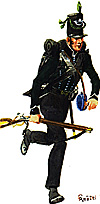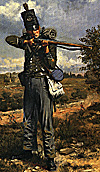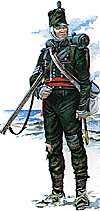One of the most famous British regiments of the Napoleonic Wars, and enjoying current vogue as the featured unit in the BBC television series based on Bernard Cornwell's best-selling Sharpe's novels, was the 95th Rifles. Originally formed in January 1800 as Manningham's Experimental Rifle Corps, it proved itself indispensable since the British light units formed during the Seven Years' and American Revolutionary Wars had been disbanded or converted into line regiments.
The French Revolutionary Wars saw the advent of new tactics, and the British sought to neutralize the effective swarms of French skirmishers. Experiments were carried out by Sir John Moore, known as the "father of modern British infantry", and others who were attempting to counter the French skirmisher and column combinations.
The official establishment of officers and men for the 95th Regiment (Rifles) in 1809 was 2,283. On 22 February, 1810 General Robert Craufurd formed the Light Division with the 95th, and the 43rd and 52nd Light Infantry. The "Light Bobs" became legendary under Wellington in such operations as the Coa River in 1810 during the French invasion of Portugal.
Three battalions existed by late 1810: the 1st was with the Peninsular Army and had participated in Moore's retreat in Spain in 1808 and the battle of Corunna on 16 January, 1809; the 2nd had gone to Walcheren off the coast of Holland; the 3rd was newly raised but took part, along with the 1st battalion, in the battles in Portugal and Spain from 1810-1812. Some detachments of the Rifles were sent to America during the War of 1812.
Wellington often broke up the battalions and attached one or more companies (of 100 men each) to each of his five (later seven) divisions, as required. On 4 August, 1810 the Light Division was divided into two brigades. Just before the siege of Ciudad Rodrigo (1 January, 1812), the 1st Brigade under Sir Andrew Barnard consisted of the 1st Battalion/43rd Light Infantry, four companies of the 1st Battalion/95th, two companies of the 2nd/95th, five companies of the 3rd/95th, and the 1st Portuguese Cacadores. The 2nd Brigade under Sir John Vandeleur comprised the 1st and 2nd Battalions/52nd Light Infantry, four companies of the 1st Battalion/95th, and the 3rd Portuguese Cacadores. Barnard, who had served with the 95th, later commanded the Light Division after Craufurd was killed at the storming of Ciudad Rodrigo.
The Rifles were employed both as light troops as well as for long-range sniping. The men typically fought in pairs. Fighting in open order, the regiment used bugles instead of drums to communicate tactical commands. As was common with many rifle and jager regiments, the 95th carried no colors.
Soldiers of the 95th wore a uniform that was very different, both in cut and color, from the traditional red coat of the British infantry. The basic color of jacket and trousers was dark green, a shade known ever since as "rifle green". The stand-up collar and cuffs were black, as was a twisted cord down the seam of each leg of the pantaloons. The collar and cuffs of black cloth were edged with white.
The jacket was cut without lapels and buttoned down to the waist, and was shaped to slope off behind without being turned back as was the normal practice. The front of the jacket was adorned with three rows of black buttons, twelve in each row, with two rows on one side and one row and the button-holes on the other.
Loose-fitting trousers were issued for guard and fatigue duty and for campaigning in place of the fitted pantaloons. Some men were issued brown trousers in lieu of the dark green. Short black gaiters of woolen cloth were worn with either type of pants, partially covering the standard issue short black boots.
Headgear consisted of a cylindrical black felt shako, the front adorned with a bugle-horn in place of the more elaborate brass plate worn by the infantry. The top front of the shako sported a green tuft of wool, and the sides were decorated with a white cockade and green cords and tassels. Top marksmen who were able to place four out of six shots on a distant target were permitted to wear a green cockade in place of the white.
Officers had silver buttons and lace instead of white, and wore a derivation of hussar-style dress. This included a dark green pelisse with brown or black fur trim (not worn on campaign), light gray trousers with red sash, light cavalry boots, and all leather-work black.
Accouterments on parade consisted of a series of black leather pouches and belts, and a scabbard for the unusual sword bayonet with two-foot blade. This bayonet was longer than the triangular bayonet issued with the India Pattern Musket. This somewhat made up for the relative short reach of the rifle (the barrel was only two and a half feet long). Oman commented that this bayonet was more appropriate for chopping wood.
A black leather waist belt was secured by a brass buckle in the shape of an S laid sideways. The bayonet scabbard, of black leather with a brass throat and chape, hung at the left hip with the round D-guard of the hilt facing forward. Just to the right of the buckle hung a small leather pouch known as the ball-bag, containing a number of lead balls. Between the ball-bag and the belt buckle a vent pricker and brush (used to clean out a fouled weapon) were suspended by a brass or iron chain.
The 95th were equipped with the Baker rifle, which was markedly different from the India Pattern Musket used by the British infantry. Comparing their weights, the India Pattern smoothbore with its bayonet fixed weighed eleven pounds, while the Baker rifle and its bayonet were only a half-pound lighter. However, since the rifle was not normally fired with its bayonet fixed (the musket often was), the actual weight of the rifle in action was more than two pounds less than the musket.
The 95th's sister regiments in the Light Division, the 43rd and 52nd Light Infantry, carried the new Land Pattern Light Infantry Musket from 1810. This was a superior design to the musket carried by the Line Regiments. Improvements included a scroll trigger-guard for a better grip, a notched V-block backsight (the India Pattern Musket of the infantry had no backsight), and a raised or semi-waterproof priming pan which increased the efficiency of the lock. The barrel was browned to prevent reflections and to inhibit rusting. Although its bore (.75 inch) and barrel length (39 inches) were the same as the India Pattern Musket, the Light Infantry barrels were more carefully bored and finished, so that with careful loading some increase in accuracy was achieved.
The Baker rifle used by the 95th, on the other hand, differed from both of these muskets in that its shorter barrel had a series of grooves. When the tight fitting ball and patch were fired, the grooves imparted a spin to the bullet. The net effect was to increase both the accuracy as well as the practical range of the Baker rifle as compared to smoothbore muskets.
The rifle was German in origin, the earliest "military" version were privately owned weapons used by huntsmen formed into special jager (sharpshooter) units. Unlike most muskets, the rifle had a back and fore sight. It was loaded in the same way as a musket, except that sometimes the bullet and its patch had to be hammered down the barrel with a mallet to insure the tightest fit. Although in the early days of the 95th the men were known to have used such mallets, contemporary sources suggest that these were abandoned as being impractical under field conditions.
The exact form of the paper cartridges is something of a mystery. These may have consisted of a patch wrapped around the ball, dipped in grease, and tied up with the powder in the normal manner. Or, the patches could have been carried separately. The rifle's inventor, Ezekiel Baker, claimed that the powder charge was three times the weight of the ball, about 100 or 110 grains, less ten grains for the priming.
When used normally the rifle had a slow rate of fire. However, one of the advantages of the Baker rifle was that it could be loaded like a smoothbore musket when the situation required more rapid firing. Jac Weller explained this asset in his Wellington at Waterloo:
"British and [King's German Legion] riflemen had a weapon which was quite different from those made on the Continent. The Baker rifle could deliver both accurate slow fire and also musket-type, relatively fast fire. If a bullet was carefully patched and forced down the bore, it could be shot precisely. If a regular paper cartridge, 'carbine' size, was used with the bullet unpatched, loading was almost as fast as with the musket. The 95th, the KGL light battalions and the light companies of KGL battalions were armed with these rifles at Waterloo. They were effective with both types of loading, depending upon whether speed or accuracy was required."
Until they ran out of ammunition, the 95th successfully defended the sand pit behind La Haie Sainte at the center of Wellington's line at Waterloo.
The average "kit" of an enlisted man consisted of two pairs of flannel drawers, two flannel shirts, two pairs of stockings and two pairs of socks, two shirts, a pair of braces, a pair of short boots, a tin of blacking and a shoe brush, a case containing a knife, fork, and spoon, a clothes brush, a hair brush, shaving box and brush, razor and case, and the straps for securing a heavy frieze greatcoat (only issued when the weather seemed likely to turn cold) and blanket to the outside of a glazed canvas knapsack. A hatchet, canteen and tin cup were carried on the outside of this kit.
When fully equipped with greatcoat and eighty rounds of ammunition, a rifleman carried nearly eighty pounds of equipment. A considerable handicap for men who were supposed to perform as "light troops"!
A description of the 95th is given in Sir Charles Oman's Wellington's Army 1809-1814:
"The most distinctive infantry uniforms in the whole army was that of the rifle battalions, whose sombre colours contrasted in the most marked way with the red of the [rest of the army]....All wore shakos of a high shape, like those of other regiments, and with a green ball or tuft at the front. The accoutrements were all black, in order to avoid showing of light or shining parts on the body, when the men were dispersed into skirmishing. In the head-dress, something like that of an eighteenth century hussar; it was a tall narrow cap, much adorned with diagonal twists of braid...; it and a green tuft to the front. The 95th officers for some time wore over their tight jackets a black furred and braided pelisse, in the hussar-style...."
The three battalions 95th Regiment (Rifles) earned their reputation as an elite unit through hard fighting from Spain to Belgium.
Craufurd's Iron Warriors Carmen, W. Y. British Military Uniforms from Contemporary Pictures: Henry VII to the Present Day. London: Leonard Hill, 1957.
About the authors:
Major Kevin F. Kiley, USMCR, is a military historian and a collector of military miniatures and prints. A veteran of the Persian Gulf and an artillery officer, he has been published in numerous magazines and periodicals and has been a regular speaker at the annual Napoleonic Society of America conference.
Dana Lombardy has edited and designed more than a dozen historical books and games. He is the publisher of Napoleon and a member of the Napoleonic Society of America.
This article appears in MagWeb (Magazine Web) on the Internet World Wide Web. The 95th fought on the battlefields in the Peninsula, earning distinction during the retreat to Corunna in 1808 when it formed the rear-guard of the rapidly disintegrating British army under Sir John Moore.
The 95th fought on the battlefields in the Peninsula, earning distinction during the retreat to Corunna in 1808 when it formed the rear-guard of the rapidly disintegrating British army under Sir John Moore.
A Unique Uniform
 Large Size of portrait at right of 95th Rifleman (very slow download--256K). Painting © by James Lancia.
Large Size of portrait at right of 95th Rifleman (very slow download--256K). Painting © by James Lancia.
 A cartridge pouch or box rested on the right hip and was suspended from the left shoulder by a broad black leather strap. From sixty to eighty rounds of paper cartridges were carried when on campaign. Just above the cartridge pouch a powder flask was suspended on a green cord with tassels, although some riflemen carried horns instead of flasks. The flask or horn was used when firing with loose powder and balls rather than with paper cartridges. A few men also carried smaller priming horns, although there is no mention of the official issue of horns and flasks.
A cartridge pouch or box rested on the right hip and was suspended from the left shoulder by a broad black leather strap. From sixty to eighty rounds of paper cartridges were carried when on campaign. Just above the cartridge pouch a powder flask was suspended on a green cord with tassels, although some riflemen carried horns instead of flasks. The flask or horn was used when firing with loose powder and balls rather than with paper cartridges. A few men also carried smaller priming horns, although there is no mention of the official issue of horns and flasks.
A Unique Weapon
Large Size Portrait 95th Rifleman (very slow download--256K).
Selected Bibliography:
Curling, Capt. (editor). Recollections of Rifleman Harris. London: 1848.
Kincaid, J. Adventures in the Rifle Brigade and Random Shots from a Rifleman (combined edition). London: undated.
Lawson, C. C. P. A History of the Uniforms of the British Army, Vol. V. London: Kaye and Ward, 1967.
Napier, Lt. Gen. Sir W. English Battles in the Peninsular. London: Chapman and Hall, 1852.
Oman, C. W. C. Wellington's Army 1809-1814. London: Edward Arnold, 1913.
Robinson, Maj. Gen. C. W. Wellington's Campaigns 1808-15 (two volumes). London: Hugh Rees, 1905.
Surtees, W. Twenty-five Years in the Rifle Brigade. London: 1833.
Back to Table of Contents -- Napoleon #2
© Copyright 1996 by Emperor's Press.
The full text and graphics from other military history magazines and gaming magazines are available at http://www.magweb.com